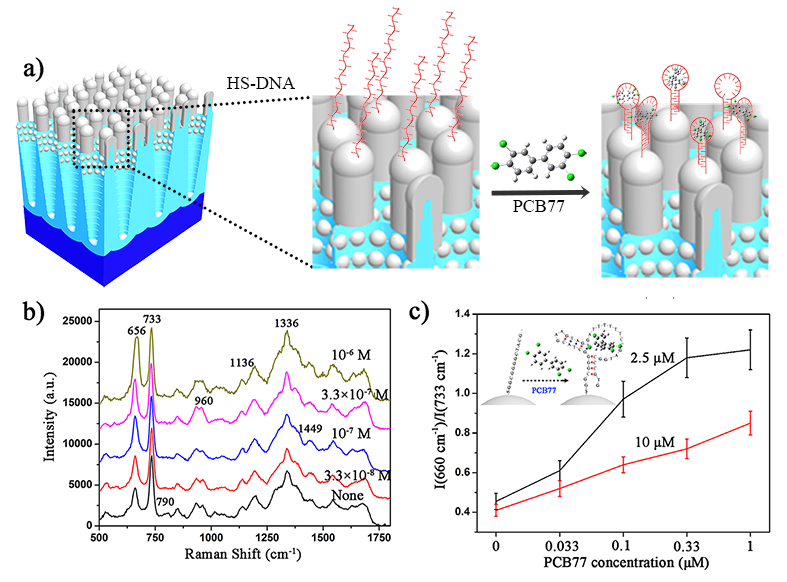
Polychlorinated biphenyls (PCBs) are notorious persistent organic pollutants (POPs) that threaten the ecosystem and cause significant toxicity to humans due to their high toxicity and bioaccumulation. Nowadays, PCBs can still be found in soils, waste disposal sites and natural waters with high concentration. Traditional methods to detect PCBs such as high-resolution capillary gas chromatography, high-resolution mass spectrometry and immunoassays are normally expensive, time-consuming and complicated.
Recently, surface-enhanced raman scattering spectroscopy (SERS) draws much attention in chemical, biological and environmental fields for its high sensitivity, real-time detection and fingerprint identification and it has been applied in PCB detection and identification.
Based on a label-free approach for the SERS detection of 3,3′,4,4′-tetrachlorobiphenyl (PCB-77), a research team led by Prof. HUANG Qing from Institute of Technical Biology and Agriculture Engineering, Hefei Institutes of Physical Science of Chinese Academy of Sciences achieves ultra-high sensitive detection of PCB-77 using the aptamer modified Ag-nanorod (Ag-NR) arrays as the SERS substrate.
The design conception is schematically depicted (Figure a). The aptamers were covalently connected to the surface of the Ag-NRs through the thiol linker. And upon binding of PCB-77, the single-stranded DNA would fold itself into a hairpin loop conformation through the hybridization of the complementary sequence, leading to the increase of the SERS signals of guanines in the aptamer.
Due to the change of the SERS signals depended upon the number of PCB-77 molecules captured by DNA aptamers, through analysis of the intensities of relevant Raman bands, namely, the 656 cm-1 (the in-ring breathing mode of guanine) and 733 cm-1 (the in-ring breathing mode of adenine) bands, the measurement of PCB-77 at low concentration could be obtained (Figure b). Especially, the SERS sensitivity could be improved with the lower concentration of the aptamers linked to the Ag-NR arrays. The detection limit was as low as 10-8 M, which is the most sensitive method as reported so far to detect the PCB-77 SERS. And the almost linear response range of the SERS substrate makes the SERS detection and quantification of PCB-77 possible (Figure c). Besides, the study team also demonstrated that it could be applied to probe trace amount of PCB-77 in natural media such as real lake water.
Such aptamer-modified Ag-NR arrays have the advantages of high SERS sensitivity, good reproducibility as well as high selectivity in the identification of target molecules. Given this, this work may open up a new path for preparation and application of large-scale highly ordered and aptamer-modified SERS substrates, which are applied to monitoring environmental pollutants with high sensitivity, selectivity and reproducibilty.
All these findings are available online in ACS Applied Materials & Interfaces entitled "Highly Sensitive and Selective Surface-Enhanced Raman Spectroscopy Label-free Detection of 3,3’,4,4’-Tetrachlorobiphenyl Using DNA Aptamer-Modified Ag-Nanorod Arrays". This work is sponsored by the National Basic Research Program of China, the National Natural Science Foundation of China and the Natural Science Foundation of Anhui Province, China.

Figure: (a) Schematic of the design of the label-free SERS-based biosensor for detection of PCB-77. (b) SERS spectra of 10 μM DNA aptamers on the Ag-NRs in response to different concentrations of PCB-77. (c) Plots of the Raman intensity ratio I(656 cm-1)/I(733 cm-1) versus the PCB-77 concentration. (Image by SUN Kexi)

86-10-68597521 (day)
86-10-68597289 (night)

86-10-68511095 (day)
86-10-68512458 (night)

cas_en@cas.cn

52 Sanlihe Rd., Xicheng District,
Beijing, China (100864)

